Analysis of Cost-Plus Method, Ratios, and Variance in Finance Mgmt
VerifiedAdded on 2023/06/10
|9
|1587
|395
Report
AI Summary
This report provides an analysis of financial resource management, beginning with an explanation of the cost-plus pricing method and its influence on decision-making. It then calculates various financial ratios, including current ratio, quick ratio, and debt-equity ratio, from the profit and loss statement of Fortune Trading Ltd. The report further explores different types of variance, such as financial budget variance, favorable and negative variances, positive variances, direct labor variances, adverse variance, and variance analysis. The conclusion emphasizes the importance of these analyses in understanding a business's efficiency, effectiveness, and overall financial health, highlighting the role of ratios and cost-plus contracts in guiding managerial decisions. Desklib offers a wealth of similar solved assignments and past papers for students seeking to enhance their understanding of finance.
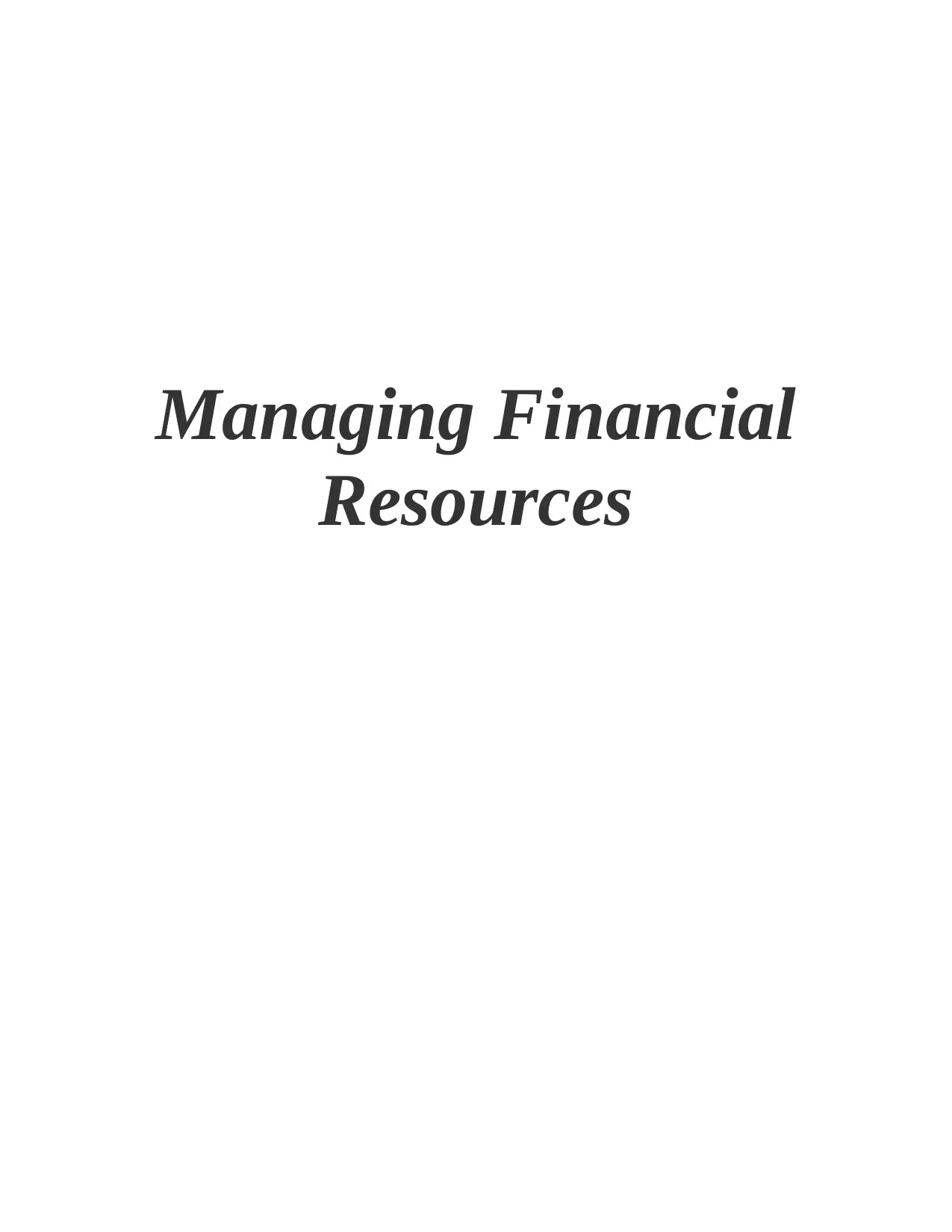
Managing Financial
Resources
Resources
Paraphrase This Document
Need a fresh take? Get an instant paraphrase of this document with our AI Paraphraser
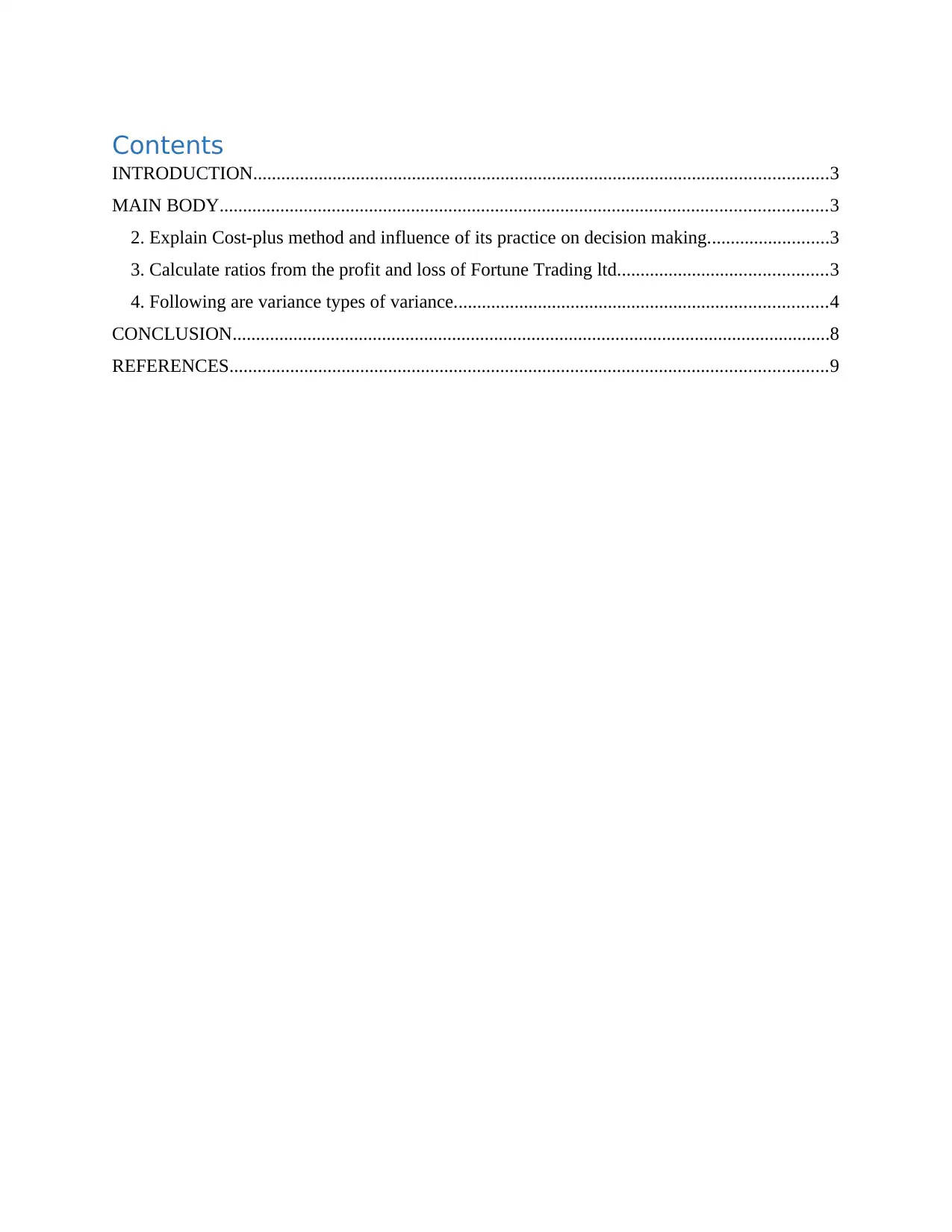
Contents
INTRODUCTION...........................................................................................................................3
MAIN BODY..................................................................................................................................3
2. Explain Cost-plus method and influence of its practice on decision making..........................3
3. Calculate ratios from the profit and loss of Fortune Trading ltd.............................................3
4. Following are variance types of variance................................................................................4
CONCLUSION................................................................................................................................8
REFERENCES................................................................................................................................9
INTRODUCTION...........................................................................................................................3
MAIN BODY..................................................................................................................................3
2. Explain Cost-plus method and influence of its practice on decision making..........................3
3. Calculate ratios from the profit and loss of Fortune Trading ltd.............................................3
4. Following are variance types of variance................................................................................4
CONCLUSION................................................................................................................................8
REFERENCES................................................................................................................................9
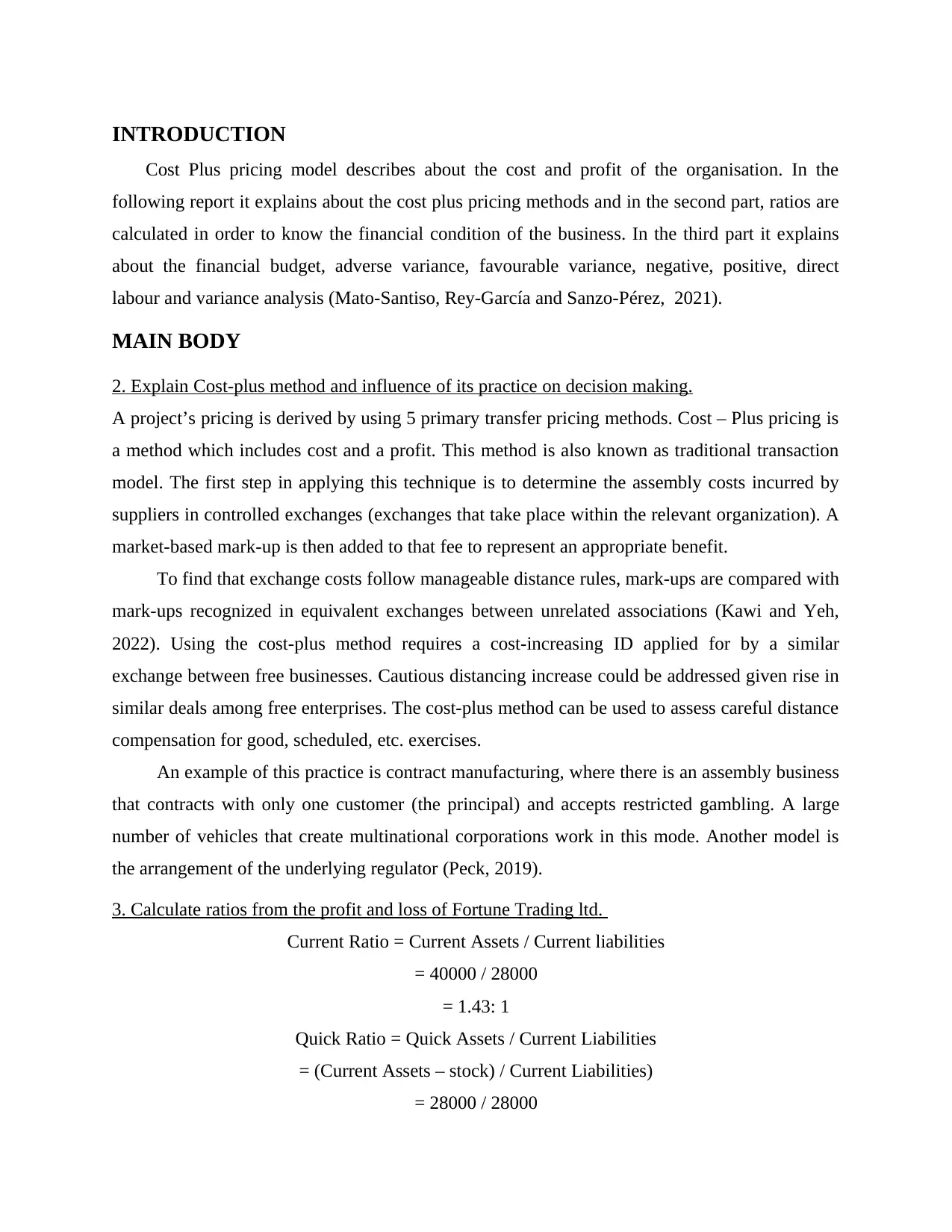
INTRODUCTION
Cost Plus pricing model describes about the cost and profit of the organisation. In the
following report it explains about the cost plus pricing methods and in the second part, ratios are
calculated in order to know the financial condition of the business. In the third part it explains
about the financial budget, adverse variance, favourable variance, negative, positive, direct
labour and variance analysis (Mato-Santiso, Rey-García and Sanzo-Pérez, 2021).
MAIN BODY
2. Explain Cost-plus method and influence of its practice on decision making.
A project’s pricing is derived by using 5 primary transfer pricing methods. Cost – Plus pricing is
a method which includes cost and a profit. This method is also known as traditional transaction
model. The first step in applying this technique is to determine the assembly costs incurred by
suppliers in controlled exchanges (exchanges that take place within the relevant organization). A
market-based mark-up is then added to that fee to represent an appropriate benefit.
To find that exchange costs follow manageable distance rules, mark-ups are compared with
mark-ups recognized in equivalent exchanges between unrelated associations (Kawi and Yeh,
2022). Using the cost-plus method requires a cost-increasing ID applied for by a similar
exchange between free businesses. Cautious distancing increase could be addressed given rise in
similar deals among free enterprises. The cost-plus method can be used to assess careful distance
compensation for good, scheduled, etc. exercises.
An example of this practice is contract manufacturing, where there is an assembly business
that contracts with only one customer (the principal) and accepts restricted gambling. A large
number of vehicles that create multinational corporations work in this mode. Another model is
the arrangement of the underlying regulator (Peck, 2019).
3. Calculate ratios from the profit and loss of Fortune Trading ltd.
Current Ratio = Current Assets / Current liabilities
= 40000 / 28000
= 1.43: 1
Quick Ratio = Quick Assets / Current Liabilities
= (Current Assets – stock) / Current Liabilities)
= 28000 / 28000
Cost Plus pricing model describes about the cost and profit of the organisation. In the
following report it explains about the cost plus pricing methods and in the second part, ratios are
calculated in order to know the financial condition of the business. In the third part it explains
about the financial budget, adverse variance, favourable variance, negative, positive, direct
labour and variance analysis (Mato-Santiso, Rey-García and Sanzo-Pérez, 2021).
MAIN BODY
2. Explain Cost-plus method and influence of its practice on decision making.
A project’s pricing is derived by using 5 primary transfer pricing methods. Cost – Plus pricing is
a method which includes cost and a profit. This method is also known as traditional transaction
model. The first step in applying this technique is to determine the assembly costs incurred by
suppliers in controlled exchanges (exchanges that take place within the relevant organization). A
market-based mark-up is then added to that fee to represent an appropriate benefit.
To find that exchange costs follow manageable distance rules, mark-ups are compared with
mark-ups recognized in equivalent exchanges between unrelated associations (Kawi and Yeh,
2022). Using the cost-plus method requires a cost-increasing ID applied for by a similar
exchange between free businesses. Cautious distancing increase could be addressed given rise in
similar deals among free enterprises. The cost-plus method can be used to assess careful distance
compensation for good, scheduled, etc. exercises.
An example of this practice is contract manufacturing, where there is an assembly business
that contracts with only one customer (the principal) and accepts restricted gambling. A large
number of vehicles that create multinational corporations work in this mode. Another model is
the arrangement of the underlying regulator (Peck, 2019).
3. Calculate ratios from the profit and loss of Fortune Trading ltd.
Current Ratio = Current Assets / Current liabilities
= 40000 / 28000
= 1.43: 1
Quick Ratio = Quick Assets / Current Liabilities
= (Current Assets – stock) / Current Liabilities)
= 28000 / 28000
⊘ This is a preview!⊘
Do you want full access?
Subscribe today to unlock all pages.

Trusted by 1+ million students worldwide
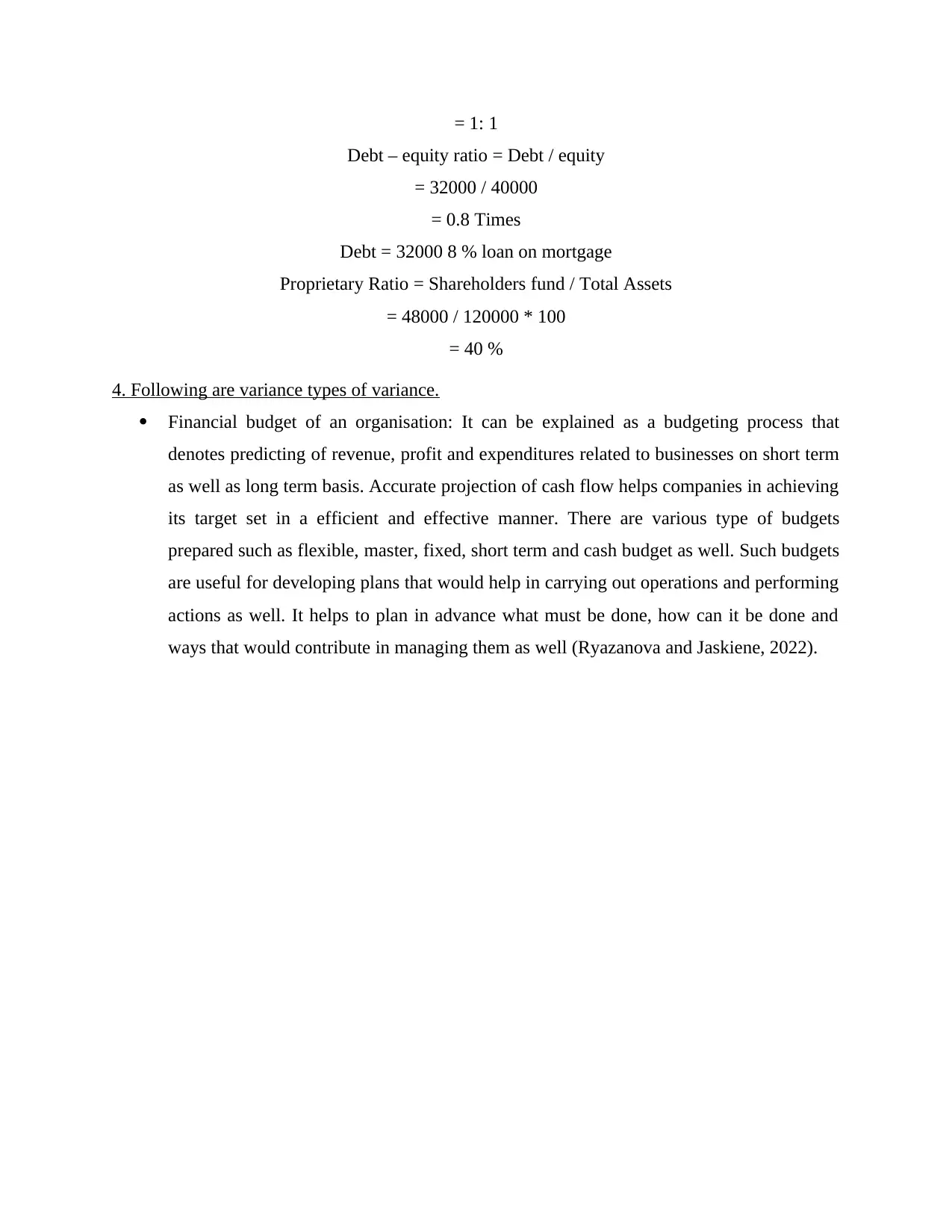
= 1: 1
Debt – equity ratio = Debt / equity
= 32000 / 40000
= 0.8 Times
Debt = 32000 8 % loan on mortgage
Proprietary Ratio = Shareholders fund / Total Assets
= 48000 / 120000 * 100
= 40 %
4. Following are variance types of variance.
Financial budget of an organisation: It can be explained as a budgeting process that
denotes predicting of revenue, profit and expenditures related to businesses on short term
as well as long term basis. Accurate projection of cash flow helps companies in achieving
its target set in a efficient and effective manner. There are various type of budgets
prepared such as flexible, master, fixed, short term and cash budget as well. Such budgets
are useful for developing plans that would help in carrying out operations and performing
actions as well. It helps to plan in advance what must be done, how can it be done and
ways that would contribute in managing them as well (Ryazanova and Jaskiene, 2022).
Debt – equity ratio = Debt / equity
= 32000 / 40000
= 0.8 Times
Debt = 32000 8 % loan on mortgage
Proprietary Ratio = Shareholders fund / Total Assets
= 48000 / 120000 * 100
= 40 %
4. Following are variance types of variance.
Financial budget of an organisation: It can be explained as a budgeting process that
denotes predicting of revenue, profit and expenditures related to businesses on short term
as well as long term basis. Accurate projection of cash flow helps companies in achieving
its target set in a efficient and effective manner. There are various type of budgets
prepared such as flexible, master, fixed, short term and cash budget as well. Such budgets
are useful for developing plans that would help in carrying out operations and performing
actions as well. It helps to plan in advance what must be done, how can it be done and
ways that would contribute in managing them as well (Ryazanova and Jaskiene, 2022).
Paraphrase This Document
Need a fresh take? Get an instant paraphrase of this document with our AI Paraphraser
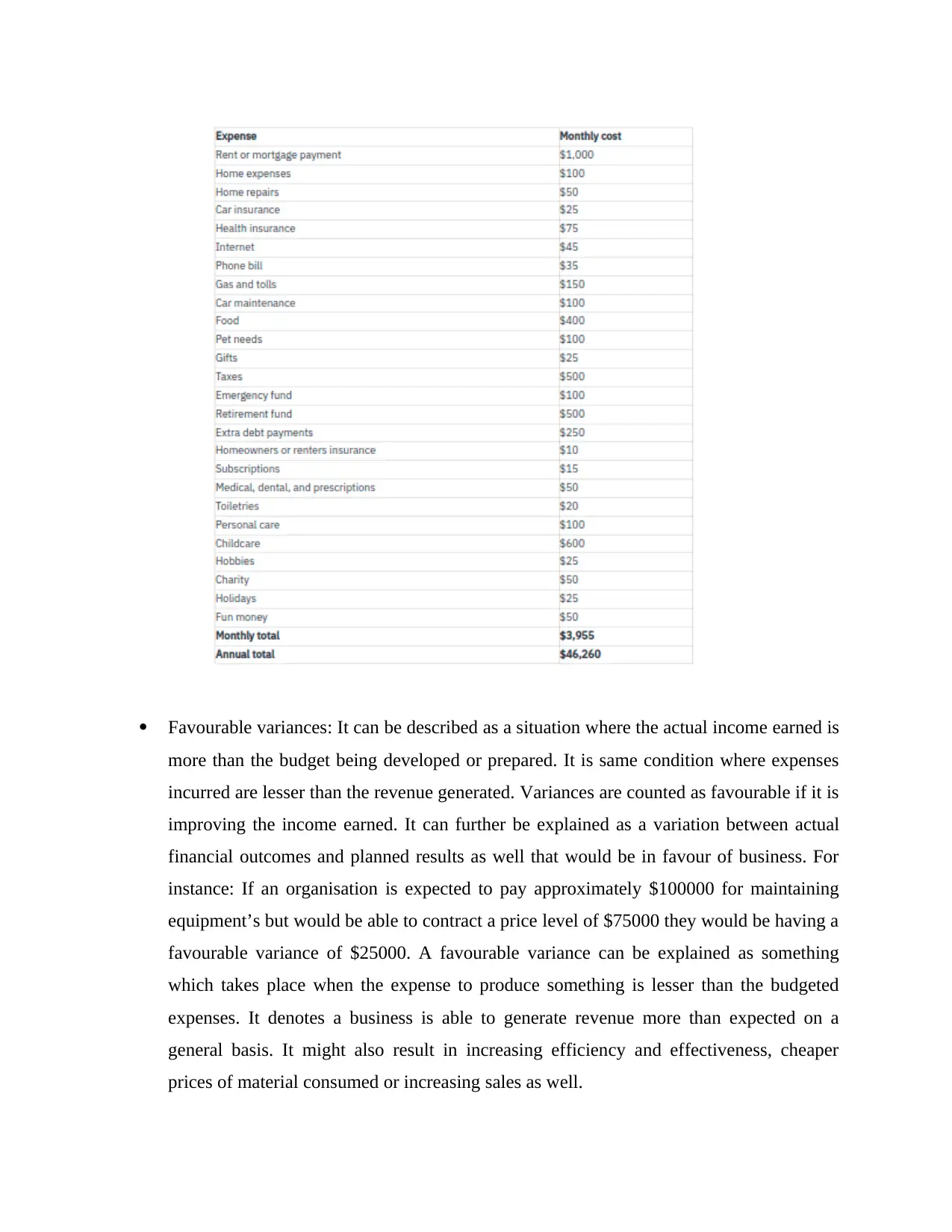
Favourable variances: It can be described as a situation where the actual income earned is
more than the budget being developed or prepared. It is same condition where expenses
incurred are lesser than the revenue generated. Variances are counted as favourable if it is
improving the income earned. It can further be explained as a variation between actual
financial outcomes and planned results as well that would be in favour of business. For
instance: If an organisation is expected to pay approximately $100000 for maintaining
equipment’s but would be able to contract a price level of $75000 they would be having a
favourable variance of $25000. A favourable variance can be explained as something
which takes place when the expense to produce something is lesser than the budgeted
expenses. It denotes a business is able to generate revenue more than expected on a
general basis. It might also result in increasing efficiency and effectiveness, cheaper
prices of material consumed or increasing sales as well.
more than the budget being developed or prepared. It is same condition where expenses
incurred are lesser than the revenue generated. Variances are counted as favourable if it is
improving the income earned. It can further be explained as a variation between actual
financial outcomes and planned results as well that would be in favour of business. For
instance: If an organisation is expected to pay approximately $100000 for maintaining
equipment’s but would be able to contract a price level of $75000 they would be having a
favourable variance of $25000. A favourable variance can be explained as something
which takes place when the expense to produce something is lesser than the budgeted
expenses. It denotes a business is able to generate revenue more than expected on a
general basis. It might also result in increasing efficiency and effectiveness, cheaper
prices of material consumed or increasing sales as well.
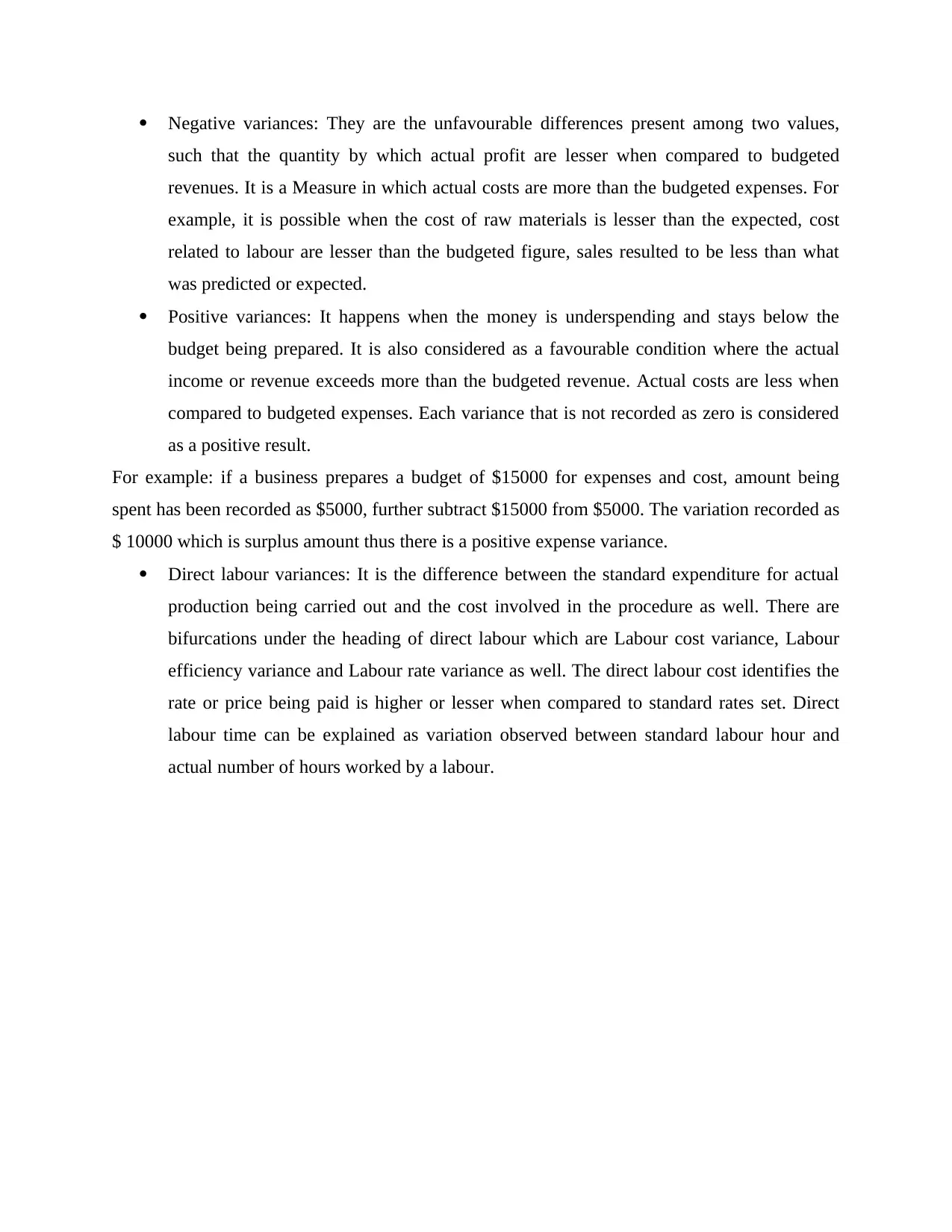
Negative variances: They are the unfavourable differences present among two values,
such that the quantity by which actual profit are lesser when compared to budgeted
revenues. It is a Measure in which actual costs are more than the budgeted expenses. For
example, it is possible when the cost of raw materials is lesser than the expected, cost
related to labour are lesser than the budgeted figure, sales resulted to be less than what
was predicted or expected.
Positive variances: It happens when the money is underspending and stays below the
budget being prepared. It is also considered as a favourable condition where the actual
income or revenue exceeds more than the budgeted revenue. Actual costs are less when
compared to budgeted expenses. Each variance that is not recorded as zero is considered
as a positive result.
For example: if a business prepares a budget of $15000 for expenses and cost, amount being
spent has been recorded as $5000, further subtract $15000 from $5000. The variation recorded as
$ 10000 which is surplus amount thus there is a positive expense variance.
Direct labour variances: It is the difference between the standard expenditure for actual
production being carried out and the cost involved in the procedure as well. There are
bifurcations under the heading of direct labour which are Labour cost variance, Labour
efficiency variance and Labour rate variance as well. The direct labour cost identifies the
rate or price being paid is higher or lesser when compared to standard rates set. Direct
labour time can be explained as variation observed between standard labour hour and
actual number of hours worked by a labour.
such that the quantity by which actual profit are lesser when compared to budgeted
revenues. It is a Measure in which actual costs are more than the budgeted expenses. For
example, it is possible when the cost of raw materials is lesser than the expected, cost
related to labour are lesser than the budgeted figure, sales resulted to be less than what
was predicted or expected.
Positive variances: It happens when the money is underspending and stays below the
budget being prepared. It is also considered as a favourable condition where the actual
income or revenue exceeds more than the budgeted revenue. Actual costs are less when
compared to budgeted expenses. Each variance that is not recorded as zero is considered
as a positive result.
For example: if a business prepares a budget of $15000 for expenses and cost, amount being
spent has been recorded as $5000, further subtract $15000 from $5000. The variation recorded as
$ 10000 which is surplus amount thus there is a positive expense variance.
Direct labour variances: It is the difference between the standard expenditure for actual
production being carried out and the cost involved in the procedure as well. There are
bifurcations under the heading of direct labour which are Labour cost variance, Labour
efficiency variance and Labour rate variance as well. The direct labour cost identifies the
rate or price being paid is higher or lesser when compared to standard rates set. Direct
labour time can be explained as variation observed between standard labour hour and
actual number of hours worked by a labour.
⊘ This is a preview!⊘
Do you want full access?
Subscribe today to unlock all pages.

Trusted by 1+ million students worldwide
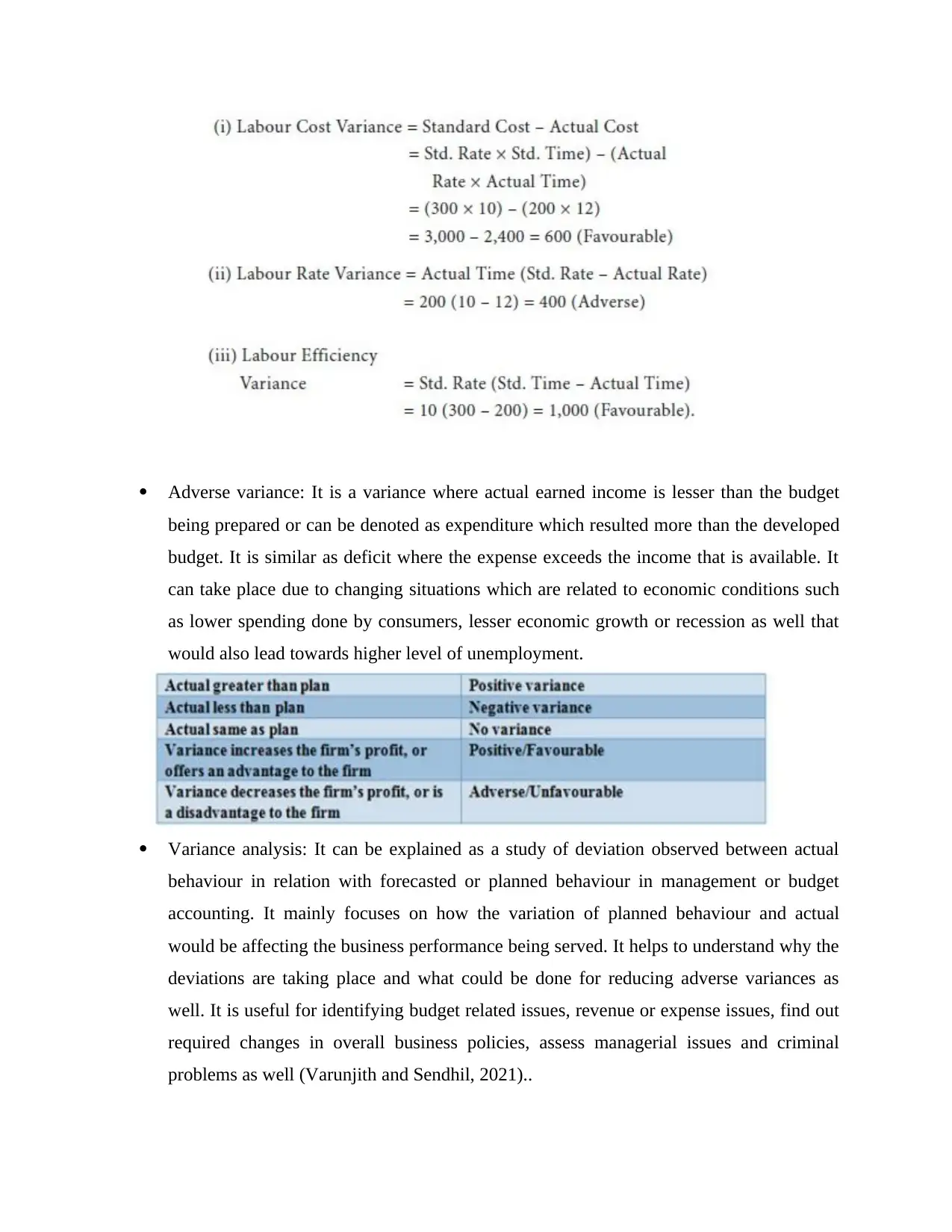
Adverse variance: It is a variance where actual earned income is lesser than the budget
being prepared or can be denoted as expenditure which resulted more than the developed
budget. It is similar as deficit where the expense exceeds the income that is available. It
can take place due to changing situations which are related to economic conditions such
as lower spending done by consumers, lesser economic growth or recession as well that
would also lead towards higher level of unemployment.
Variance analysis: It can be explained as a study of deviation observed between actual
behaviour in relation with forecasted or planned behaviour in management or budget
accounting. It mainly focuses on how the variation of planned behaviour and actual
would be affecting the business performance being served. It helps to understand why the
deviations are taking place and what could be done for reducing adverse variances as
well. It is useful for identifying budget related issues, revenue or expense issues, find out
required changes in overall business policies, assess managerial issues and criminal
problems as well (Varunjith and Sendhil, 2021)..
being prepared or can be denoted as expenditure which resulted more than the developed
budget. It is similar as deficit where the expense exceeds the income that is available. It
can take place due to changing situations which are related to economic conditions such
as lower spending done by consumers, lesser economic growth or recession as well that
would also lead towards higher level of unemployment.
Variance analysis: It can be explained as a study of deviation observed between actual
behaviour in relation with forecasted or planned behaviour in management or budget
accounting. It mainly focuses on how the variation of planned behaviour and actual
would be affecting the business performance being served. It helps to understand why the
deviations are taking place and what could be done for reducing adverse variances as
well. It is useful for identifying budget related issues, revenue or expense issues, find out
required changes in overall business policies, assess managerial issues and criminal
problems as well (Varunjith and Sendhil, 2021)..
Paraphrase This Document
Need a fresh take? Get an instant paraphrase of this document with our AI Paraphraser
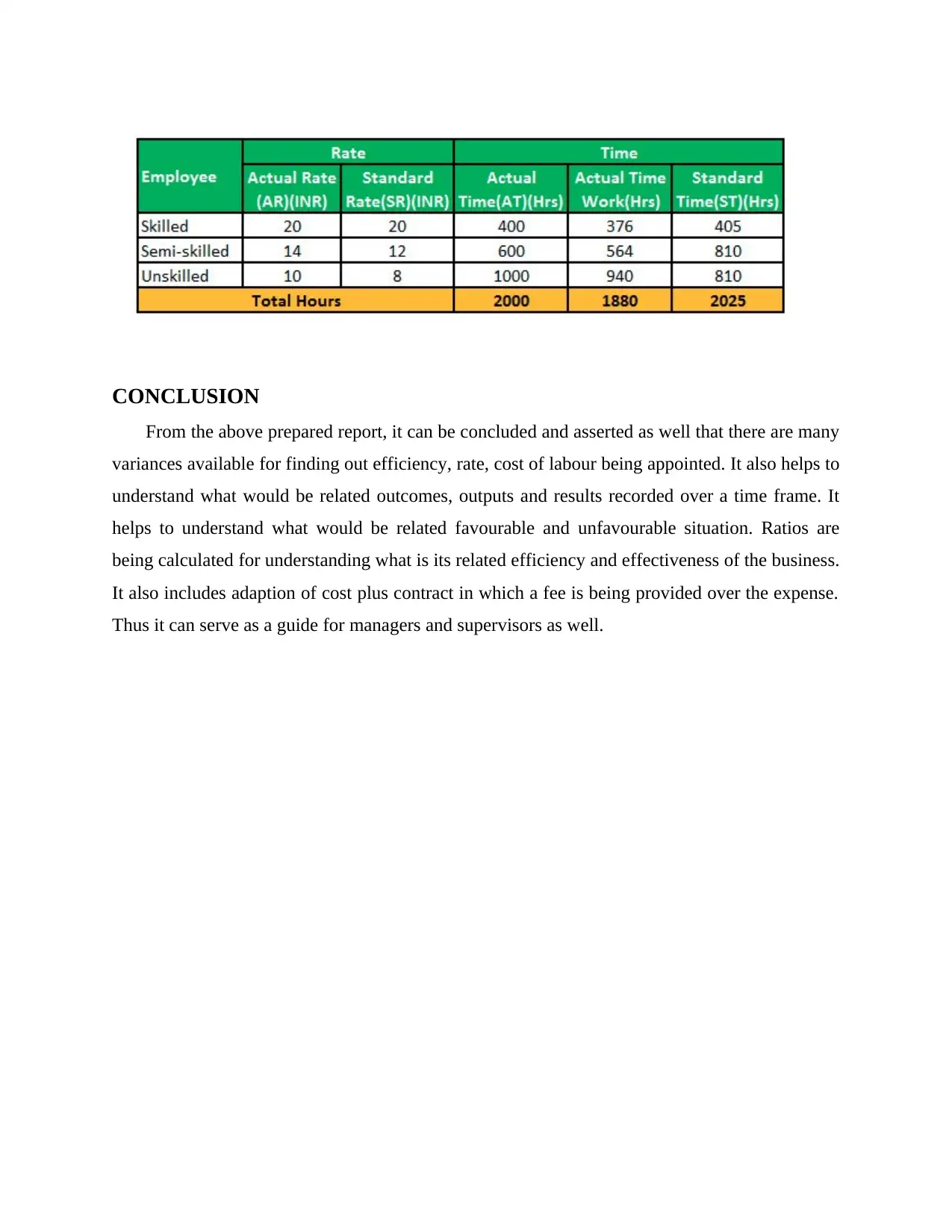
CONCLUSION
From the above prepared report, it can be concluded and asserted as well that there are many
variances available for finding out efficiency, rate, cost of labour being appointed. It also helps to
understand what would be related outcomes, outputs and results recorded over a time frame. It
helps to understand what would be related favourable and unfavourable situation. Ratios are
being calculated for understanding what is its related efficiency and effectiveness of the business.
It also includes adaption of cost plus contract in which a fee is being provided over the expense.
Thus it can serve as a guide for managers and supervisors as well.
From the above prepared report, it can be concluded and asserted as well that there are many
variances available for finding out efficiency, rate, cost of labour being appointed. It also helps to
understand what would be related outcomes, outputs and results recorded over a time frame. It
helps to understand what would be related favourable and unfavourable situation. Ratios are
being calculated for understanding what is its related efficiency and effectiveness of the business.
It also includes adaption of cost plus contract in which a fee is being provided over the expense.
Thus it can serve as a guide for managers and supervisors as well.
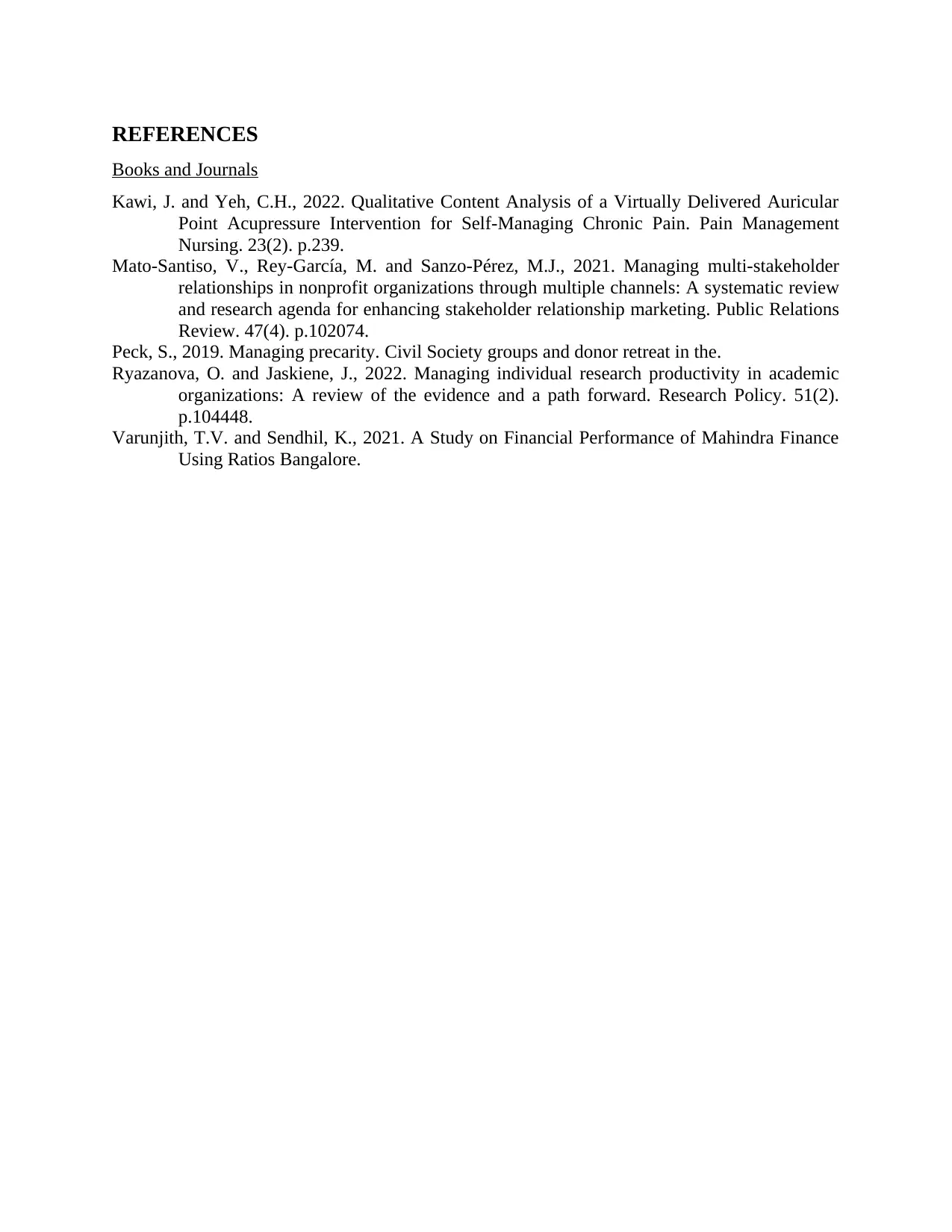
REFERENCES
Books and Journals
Kawi, J. and Yeh, C.H., 2022. Qualitative Content Analysis of a Virtually Delivered Auricular
Point Acupressure Intervention for Self-Managing Chronic Pain. Pain Management
Nursing. 23(2). p.239.
Mato-Santiso, V., Rey-García, M. and Sanzo-Pérez, M.J., 2021. Managing multi-stakeholder
relationships in nonprofit organizations through multiple channels: A systematic review
and research agenda for enhancing stakeholder relationship marketing. Public Relations
Review. 47(4). p.102074.
Peck, S., 2019. Managing precarity. Civil Society groups and donor retreat in the.
Ryazanova, O. and Jaskiene, J., 2022. Managing individual research productivity in academic
organizations: A review of the evidence and a path forward. Research Policy. 51(2).
p.104448.
Varunjith, T.V. and Sendhil, K., 2021. A Study on Financial Performance of Mahindra Finance
Using Ratios Bangalore.
Books and Journals
Kawi, J. and Yeh, C.H., 2022. Qualitative Content Analysis of a Virtually Delivered Auricular
Point Acupressure Intervention for Self-Managing Chronic Pain. Pain Management
Nursing. 23(2). p.239.
Mato-Santiso, V., Rey-García, M. and Sanzo-Pérez, M.J., 2021. Managing multi-stakeholder
relationships in nonprofit organizations through multiple channels: A systematic review
and research agenda for enhancing stakeholder relationship marketing. Public Relations
Review. 47(4). p.102074.
Peck, S., 2019. Managing precarity. Civil Society groups and donor retreat in the.
Ryazanova, O. and Jaskiene, J., 2022. Managing individual research productivity in academic
organizations: A review of the evidence and a path forward. Research Policy. 51(2).
p.104448.
Varunjith, T.V. and Sendhil, K., 2021. A Study on Financial Performance of Mahindra Finance
Using Ratios Bangalore.
⊘ This is a preview!⊘
Do you want full access?
Subscribe today to unlock all pages.

Trusted by 1+ million students worldwide
1 out of 9
Related Documents
Your All-in-One AI-Powered Toolkit for Academic Success.
+13062052269
info@desklib.com
Available 24*7 on WhatsApp / Email
![[object Object]](/_next/static/media/star-bottom.7253800d.svg)
Unlock your academic potential
Copyright © 2020–2025 A2Z Services. All Rights Reserved. Developed and managed by ZUCOL.




